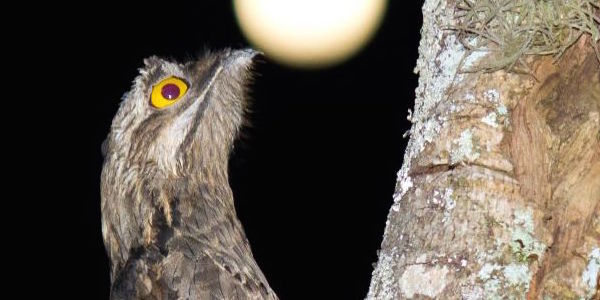LINKED PAPER
Citizen science data reveals the cryptic migration of the Common Potoo Nyctibius griseus in Brazil. DeGroote, L.W., Hingst-Zaher, E., Moreira-Lima, L., Whitacre, J.V., Slyder, J.B., Wenzel, J.W. 2020. IBIS. DOI: 10.1111/ibi.12904 VIEW

I can think of few birds as charismatic as a Potoo. Their plumage, structure and posture allow them to masquerade as broken branches or stumps; a feat they sometimes attempt in the open, bold as brass on fenceposts and bottles (Cestari et al. 2018). Notches in their eyelids allow them to watch intruders with eyes closed or nearly so. When open, these eyes are large, bright yellow with pupils that are often asymmetrically dilated. Paired with their large mouth, Potoos are the posterchild of derpy bird memes. The mournful descending cry of the Common Potoo, Nyctibius griseus, is the subject of poetry and lore. Alexander Skutch (1970) described the Common Potoo’s voice as “the most melancholy utterance I had ever heard from bird or beast. Although plaintive, the Potoo’s soft, soprano notes were so beautifully modulated that they brought to mind a phrase from Shelley’s Adonais, ‘most musical of mourners’”. In folklore Potoos are similarly anthropomorphized as mourning the loss of a loved one. A child crying for their mother who abandoned them, a chieftain’s daughter mourning her suitor murdered by her father, or a wife crying for her husband who left and became the moon because she didn’t prepare enough pumpkin for dinner (Hernandez 2016, WikiAves 2020). These legends and others form the root of their name in Brazil where they are called Mãe-da-lua “Mother of the Moon” or by the Tupi of the Amazon as Urutau “ghost bird”. For all these reasons, Common Potoos are highly sought after by birders and photographers. Could we perhaps use data collected by this community to follow up on Belton’s (1984) observation that the “migratory status [is] not certain because most records [are] based on voice and it could be here undetected in winter if silent then”?
We used data from WikiAves and eBird to determine whether the Common Potoo migrates from the southern portion of its range (eBird 2020, WikiAves 2020). WikiAves is a citizen science dataset unique to Brazil and, like iNaturalist, is primarily comprised of photographic records verified by the WikiAves community (WikiAves 2020). We tallied observations into 1-degree latitude bins and plotted cumulative distribution curves for Potoos observed October to February (during the southern region’s austral Summer) and May to August (Winter) from the equator south. Think of it as if you were walking south, counting Potoos as you go and later plotting the cumulative ratio seen at each latitudinal benchmark. We tested if these cumulative distribution curves were different from one another using a non-parametric Kolmogorov–Smirnov (KS) test.
But how do we address Belton’s (1984) conundrum of silence vs absence? First, we conducted the same tests on daytime records only. Because Common Potoos primarily vocalize at night, we presume that most of the birds were found visually (though some could have been heard at night and later found during the day). Second, we conducted the same tests on two other nocturnal species, the Common Pauraque and Tropical Screech Owl.

Figure 1 Cumulative percentage of Common Potoos observed from the Equator to 36°S latitude from eBird (left column) and WikiAves (right column) data for all observations (top row) and daytime observations (bottom row) by season (Summer, black line and solid circles; Winter, dashed line and open circles).
We found that Common Potoos were distributed further north during the austral Winter than Summer for diurnal and all observations together. Neither Common Pauraques or Tropical Screech Owls shifted their range latitudinally between seasons. In addition, MaxEnt models demonstrated that Common Potoos departed the southern colder regions for locations with warmer and wetter winters, a partial migration that mirrors that of many long-distant migrant flycatchers (Chesser 2005).

Figure 2 Distribution of Common Potoos using data from WikiAves (A, B), eBird (C, D) and both datasets (E, F) during the austral Summer (October–February) and Winter (May–August).
Our study is the first to provide evidence of migration for any member of the family Nyctibiidae. Until now, the partial migration of the Common Potoo, charismatic as it is, has been masked by its diurnal camouflage and nocturnal foraging. Citizen science (i.e. community science) datasets including and beyond eBird, may offer a means to study the migratory status of South American birds without relying on patchy historical records or expensive, individualized tracking technology. Moreover, because these datasets are rapidly expanding, and the utility of these datasets grows with increasing observations, researchers may soon be able to model the status and trends of South American birds and habitat requirements of many varied South American migrants throughout their annual life cycle. Data from the community within South America, therefore, could lead us to a better understanding of austral migration and, eventually, the ecology and preservation of South American birds.
References
Belton, W. 1984. Birds of Rio Grande do Sul, Brazil. Part 1. Rheidae through Furnariidae. Bulletin of the American Museum of Natural History 178: 369-636. VIEW
Cestari, C., Gonçalves, C.S. & Saxima, A. 2018. Use flexibility of perch types by the branch-camoulfaged Common Potoo (Nyctibius griseus): why this bird may occasionally dare to perch on artificial substrates. The Wilson Journal of Ornithology 130: 191-199. VIEW
eBird. 2020. An online database of bird distribution and abundance [web application]. Ithaca, NY: eBird, Cornell Lab of Ornithology. VIEW
Hernandez, L. 2016. Tell me the legend of the singing bird “Potoo”! VIEW
Skutch, A.F. 1970. Life history of the Common Potoo. Living Bird 9: 265-280. VIEW
WikiAves. 2020. WikiAves – A enciclopedia das aves do Brasil. VIEW
Image credit
Top right: Common Potoo Nyctibius griseus © Fernando Cipriani
If you want to write about your research in #theBOUblog, then please see here.



